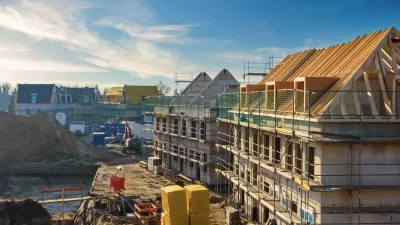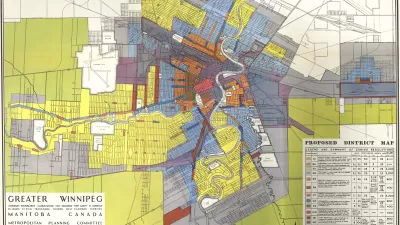In April 2009, HUD Secretary Shaun Donovan spoke to the ULI Spring Council Forum in Atlanta; he stated that his administration’s goal was “to put the UD back in HUD,” and explained that HUD’s over-reliance on housing solutions wasn’t helping cities address their complex revitalization needs. Just over two years later, this small new funding program caught my eye on a list of new HUD announcements: *** HUD HOPE VI – $0.5 million Application Due: August 22, 2011 Eligible Entities: Local governments
In April 2009, HUD Secretary Shaun Donovan spoke to the ULI
Spring Council Forum in Atlanta; he stated that his administration's goal was
"to put the UD back in HUD," and explained that HUD's over-reliance on housing
solutions wasn't helping cities address their complex revitalization needs. Just over two years later, this small new funding program
caught my eye on a list of new HUD announcements:
*** HUD HOPE VI – $0.5 million
Application Due: August 22, 2011
Eligible Entities: Local governments
HUD requests proposals for the HOPE VI Main Street Program.
This program provide grants to small communities to assist in the rejuvenation
of an historic or traditional central business district or "Main Street" area
by replacing unused commercial space in buildings with affordable housing
units. HUD encourages activities that actively promote sustainability through
enhancing energy efficient measures.
Now, I suppose it
would be fair to assume that a community who applies for this program has
already studied the parcels and "Main Street" area in question and made a
determination that housing would be a long-term better usage of the land than
the existing commercial use, but it strikes me as exceeding the bounds of the
federal government to make the presumption on behalf of eligible small
communities that this land use change should be made. Indeed, the program is
only open to communities with 50,000 or fewer residents, which describes
communities that don't often have a surfeit of professional planning capacity
to study a question like this before chasing federal funds. HUD could have made
one of the eligibility criteria that the locality has a comprehensive plan or
zoning in place that would support this dramatic land use change. By not doing
so, this program seems to encourage the local funding recipient to enact a spot
rezoning for the affected properties.
The stated objectives of the program are to: "Redevelop Main
Street areas; Preserve historic or traditional architecture or design features
in Main Street areas; Enhance economic development efforts in Main Street
areas; and Provide affordable housing in Main Street areas." Of these goals,
only the fourth (providing affordable housing) is clearly met by every
allowable expenditure under the program. Replacing viable downtown commercial
space with housing units seems like a questionable move towards "enhancing
economic development" and from the
perspective of preserving historic and traditional architecture, rehabilitating
older downtown buildings for re-use as housing is generally only preferable if
the only alternative is to tear the obsolete structure down.
Especially in the current economic climate, which has
created extreme volatility in many communities' retail, restaurant, office, and
light manufacturing industries, I can see many communities being interested in
the idea of using federal funds to address vacant storefronts through this
program, but I'm not sure it's wise for them to do so. Hundreds of small
downtowns are struggling now, but removing commercial space, breaking up what
little retail continuity exists, and adding first floor residences that are
bound to close themselves from the street seem like moves that will facilitate rather
than stop the pattern of decline. Why not use this funding to promote
developing additional affordable housing units on vacant land or land that is adjacent
to existing downtowns? Predicating the funding on
a local land use change from commercial to residential incentivizes short-term
decision making, and leaves a lot of "UD" still left to do for struggling small
downtowns.
I'm curious:
-
Do you
know any communities who applied? -
Can you
think of smaller downtowns that would benefit from this program? -
Do you
think it's advisable to make such a dramatic land use shift? -
Do you
have examples of affordable housing in small downtowns that are located in formerly commercial
space and contribute to the downtown's economic development?
I'll watch for the results of this funding and report back
about the community(ies) that are awarded.

Maui's Vacation Rental Debate Turns Ugly
Verbal attacks, misinformation campaigns and fistfights plague a high-stakes debate to convert thousands of vacation rentals into long-term housing.

Planetizen Federal Action Tracker
A weekly monitor of how Trump’s orders and actions are impacting planners and planning in America.

In Urban Planning, AI Prompting Could be the New Design Thinking
Creativity has long been key to great urban design. What if we see AI as our new creative partner?

Massachusetts Budget Helps Close MBTA Budget Gap
The budget signed by Gov. Maura Healey includes $470 million in MBTA funding for the next fiscal year.

Milwaukee Launches Vision Zero Plan
Seven years after the city signed its Complete Streets Policy, the city is doubling down on its efforts to eliminate traffic deaths.

Portland Raises Parking Fees to Pay for Street Maintenance
The city is struggling to bridge a massive budget gap at the Bureau of Transportation, which largely depleted its reserves during the Civd-19 pandemic.
Urban Design for Planners 1: Software Tools
This six-course series explores essential urban design concepts using open source software and equips planners with the tools they need to participate fully in the urban design process.
Planning for Universal Design
Learn the tools for implementing Universal Design in planning regulations.
Gallatin County Department of Planning & Community Development
Heyer Gruel & Associates PA
JM Goldson LLC
City of Camden Redevelopment Agency
City of Astoria
Transportation Research & Education Center (TREC) at Portland State University
Jefferson Parish Government
Camden Redevelopment Agency
City of Claremont






























